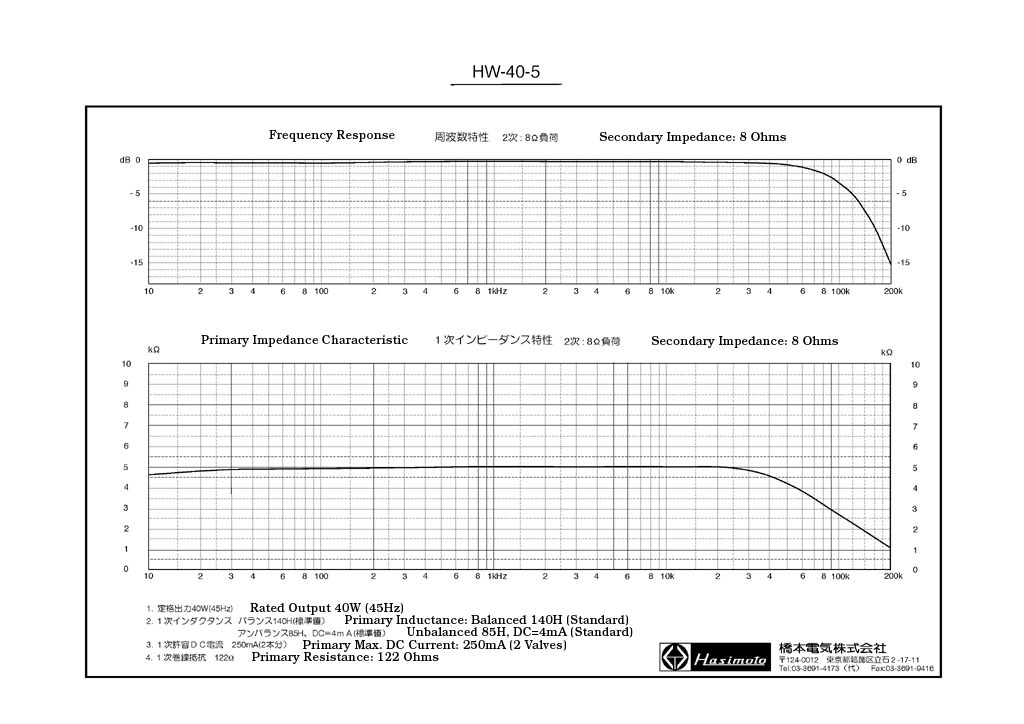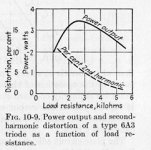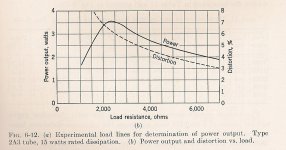Will be worse at low frequency because primary inductance stays the same. So you will only get you reflected load from some 100-200 Hz and above depending on the secondary load...Excellent point that I should have considered. What are the downsides of using a 4 ohm secondary with 8 or 16 (or even) 32 ohm loads to get a higher reflected primary load?
High frequency behaviour will also change because the transformer has likely been designed for much lower source impedance.
One other thing that I have been thinking about is the input. I may need to use a small input transformer to get the desired voltage swing from a solid state source, but won't the secondary of that transformer see the negative DC of the grid and does that mean that is have to be gapped for the DC? Or do I still need an input capacitor?
In theory there should be no problem if the tube is good. You might see some grid current at full output but generally most transformer cores have a natural small gap that will handle it until it enters the positive grid region. You might have problems with lilliputian permalloy transformers or un-cut core transformers. Anyway you can put a jfet/mosfet source follower as a buffer and solve it. The source follower will also give you other benefits like lower input capacitance (very desirable if you want to use a step-up input transformer) and fixed bias. Tradeoff is more "complicated" power supply.
If you want to build a 1W spud amp without any complication I would suggest the 6e5p in triode mode. Running the tube at 200-220V with about 30mA and 2.5-3K load you would get AT LEAST 1W with 3-3.5V peak drive. So no need of input transformers or other gain stages if you have a good source. A simple grid resistor, a 1K grid stopper and self bias with approx. 100-120R (bypassed) cathode resistor if you already have the volume control at the source....It doesn't come any simpler than this I think. The 6e5p is cheap, finding a 2.5-3K small transformer is a lot easier and cheaper and performance will be better regardless of the cost!
Last edited:
Properly loaded, say Rl is at least 2X rp, the LF rolloff is dominated by the triode rp, not the speaker impedance. But for a pentode, the freq response simply follows the reflected impedance with all the dips & dives of the speaker load. That is where some of the problems in NFB amplifiers originate.
For information only.🙂
For information only.🙂
Frequency response is the least of problems. If one loads a transformer with 16-32R when this has been designed to work with 4R there will be no proper loading, in particular at low frequency. That's the point. The reflected impedance for a given secondary load does not depend on the source impedance of the tube. Low frequency performance is dominated by the ratio XL/Req where Req is source resistance in parallel with the nominal load (resistive). That ratio should be as high as possible hence inductance should be as high as possible. No one makes, for example, a SE 5K/4R (this would become 20K for 16R and 40K for 32R) with enormous inductance because it would mean huge size for the task or massive insertion loss. Or both!
Here is a case where frequency response has been measured using a source impedance equal to the nominal load:

Frequency response looks quite good despite 1X load! However power response will be poor. The reflected impedance at 20Hz has nearly halved. The lower the inductance the higher the distortion which will be easily in double digits in SE amps already at medium output levels. A typical good quality 5K SE transformer has got about 30H (in the case above it's rated 25H but it is measured with small signal and will get to 30H or a bit more at full throttle, still being a bit signal dependent) while a good 5K PP transformer has easily got 5-10x. Like in this other case from the same manufacturer using the same design principles, the same materials and getting about the same (actually a bit better) insertion loss:

Actually the SE transformer above is the top of the range while the PP is not! The top of the range PP transformer is even better! Between SE and PP there is quite a difference. The assumption of proper loading based on transformer nominal impedance is only valid for the PP case.
Here is a case where frequency response has been measured using a source impedance equal to the nominal load:

Frequency response looks quite good despite 1X load! However power response will be poor. The reflected impedance at 20Hz has nearly halved. The lower the inductance the higher the distortion which will be easily in double digits in SE amps already at medium output levels. A typical good quality 5K SE transformer has got about 30H (in the case above it's rated 25H but it is measured with small signal and will get to 30H or a bit more at full throttle, still being a bit signal dependent) while a good 5K PP transformer has easily got 5-10x. Like in this other case from the same manufacturer using the same design principles, the same materials and getting about the same (actually a bit better) insertion loss:

Actually the SE transformer above is the top of the range while the PP is not! The top of the range PP transformer is even better! Between SE and PP there is quite a difference. The assumption of proper loading based on transformer nominal impedance is only valid for the PP case.
Last edited:
No one makes, for example, a SE 5K/4R (this would become 20K for 16R and 40K for 32R) with enormous inductance because it would mean huge size for the task or massive insertion loss. Or both!
Edcor makes two. 10W for $30, and 25W for $100. You should edit your post for correctness because it will now be part of the cloud forever and ever for all to read and be misled by. OH! You can't because DIYAudio has a time limit. Smart....
Edcor makes two. 10W for $30, and 25W for $100. You should edit your post for correctness because it will now be part of the cloud forever and ever for all to read and be misled by. OH! You can't because DIYAudio has a time limit. Smart....
I will edit my post if you explain how inductance can be assessed by generic power rating with ZERO information about frequency, induction and insertion loss.. Moreover I really doubt you understand what I wrote. That's because of your nonsensical quote and comment.
Two transformers can have different power rating as above but same primary impedance and same inductance. Actually the smaller transformer could have more inductance hence better low frequency performance within its power rating!
Last edited:
Load Rl equal to triode rp is not a good place to be. D% goes thru the roof. And at large signal peak currents don't look good either!😀 These examples lifted straight from the EE text books of that era.
Attachments
Load Rl equal to triode rp is not a good place to be. D% goes thru the roof.
Of course Rl=rp is not a good choice. That's what we have been saying until now. This is only used to measure the FR of transformers for generic use. Most Jap transformers are specified this way so you can compare straightaway. Same for the other specs like primary inductance typically done at just 5V @50Hz, power rating at specific low frequency and insertion loss. The 5K (expensive) transformer above is likely to be used with 300B and similar stuff so it will actually behave better! Here however the problem is that one wants to build a low power amp with high rp tube. That's not for sure the best choice. If then this is compromised also using a transformer that at low frequency has not enough inductance the result is not going to be that good before building it.....
If one uses 18K for the 6J5, which is 2.3x, inductance should be at least in the region of 100H otherwise the low frequency distortion will be high. Can one find me a SE 5K/4R transformer (20K when used with 16R) that has got 100H? I doubt that the Edcor 5K SE transformers have such inductance.
Last edited:
Assuming a 6J5, reflected Rl to be 3X rp & a 10H OPT, stuffing the numbers in & turning the crank gets a 3db LF of ~85 Hz. The Hammond 125 SE series claims something like 10H.
There are much better tube choices for this socket.🙂
There are much better tube choices for this socket.🙂
There are much better tube choices for this socket.🙂
I agree 100%. Especially if it has to be cheap and simple. The 6e5P in triode connection (approx 1-1.2K Rp) only requires 2.5-3 K for a super-simple, well performing spud amp. Of course one can go up to 5-7K primary load for lower distortion but these are all standard off-shelf transformer impedances anyway....
- Status
- Not open for further replies.
- Home
- Amplifiers
- Tubes / Valves
- 6J5 amplifier

